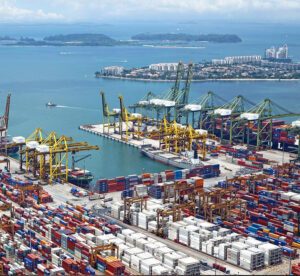What are the inflationary effects of global logistics?
Inflationary Effects of Global Logistics. From the vantage of a worldwide manufacturing organization’s in-transit inventory perspective, the total cost of ownership includes the purchase price and all associated direct, indirect, and hidden costs.
Prior to the onset of the covid pandemic, end-to-end (E2E) supply chain costs were relatively stable for decades. Maritime commodity container shipping charges from China to US West Coast Ports were $1850.00, with empty returns being $750.00.
As the pandemic progressed, commodity container shipping charges from China fluctuated from their lows to over thirty-thousand dollars per one-way trip, settling in to the current fifteen-thousand-dollar variable approximation. In February 2021, with undiminishing port congestion disruptions, I coined the phrase “Someone has to pay for the boat.”

Still, the US economy was resilient enough to absorb most of the ongoing hidden cost spikes of global logistics. As transport costs exploded exponentially, shippers became unwilling to participate in normalizing the global container distribution by returning empties to points of origin. Some shippers were reportedly even dumping US ag’ products to minimize the cleaning turn-around time of containers. Unsustainable practices of shippers exacerbated logistical congestion bottlenecks.
By September 2021, port congestion disruptions had devolved into the intermodal throughput capacity variability of the bull-whip effect, E2E, throughout the global supply chain logistics network. Worldwide manufacturing organizations, seeing a projected long-term increase in their logistical costs, broke four decades of cost reduction precedence, electing to pass them down the consumer food group (CFG) value-chain to customers resulting in a 25% increase felt at Point of Sale (POS). To date, the inflationary POS increases have expanded and are exceeding 40%.
The price of diesel which over-the-road trucks require has increased from $3.00 a gallon and now exceeds $7.00 a gallon in many locations putting further strain on the economy. Economists seem to be having contradictory views on inflationary trends.
 With container costs and fuel far from their pre-pandemic norms, with pandemic hotspots, US-China Tariff effects, labor disputes & retention issues, and authoritarian military adventurism on the rise, it seems obvious we are in a long-term inflationary trend.
With container costs and fuel far from their pre-pandemic norms, with pandemic hotspots, US-China Tariff effects, labor disputes & retention issues, and authoritarian military adventurism on the rise, it seems obvious we are in a long-term inflationary trend.
Establishing efficiencies within the logistics of global supply chains is essential and urgent to level, then initiate significant reductions in the current inflationary period.
